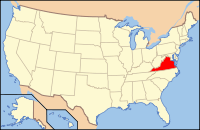Maymont
| Maymont | |
|---|---|
 Maymont Mansion was originally owned by Maj. James H. Dooley and his wife Sallie. | |
| Location | Entrances at 2201 Shields Lake Drive, 1700 Hampton Street, Richmond, Virginia |
| Coordinates | Coordinates: 37°32′7″N 77°28′40″W / 37.53528°N 77.47778°W |
| Area | 100 acres (40 ha) |
| Created | 1925 |
| Operated by | Maymont Foundation |
| Open | Year-round |
| Website | http://www.maymont.org/ |
|
Maymont | |
| Coordinates | 37°32′5″N 77°28′43″W / 37.53472°N 77.47861°W |
| Area | 100 acres (40.5 ha) |
| Built | 1890 |
| Architect | Edgerton S. Rogers |
| Governing body | Local |
| NRHP Reference # | 71001062[1] |
| VLR # | 127-0182 |
| Significant dates | |
| Added to NRHP | December 16, 1971 |
| Designated VLR | July 6, 1971[2] |
Maymont is a 100 acre (0.156 m²) Victorian estate in Richmond, Virginia, an extraordinary gift given to the community. It contains Maymont Mansion, now a historic house museum, an arboretum, formal gardens, a carriage collection, native wildlife exhibits, a nature center, and Children's Farm.
In 1893, Major James H. Dooley, a wealthy Richmond lawyer and philanthropist, and his wife, Sallie, completed their elaborate Gilded Age estate on a site high above the James River. According to their wishes, after their deaths Maymont was left to the people of Richmond. Over the next 75 years, additional attractions were added.
History
Maymont was named for Major Dooley's wife, Sallie May.[3] Construction began in 1890,[4] with the mansion completed in 1893.[5]
The Dooleys also built a summer home on Afton Mountain, Swannanoa, which was completed in 1913.[5]
In 2011, Maymont was named one of the top 10 public spaces by the American Planning Association.
The gardens

The Japanese Garden at Maymont is well tended and features a koi pond as well as a large waterfall. The Italian Garden features a pergola, fountains, urns and roses.
The arboretum contains more than 200 species of trees and woody plants. It includes a number of "exotic champions" including a Cedrus atlantica, Cryptomeria japonica, Parrotia persica, and Tilia europea.
Maymont's gardens are popular for outdoor weddings focused around the Italian Garden, the Japanese Garden and numerous gazebos located throughout the grounds.
Fauna
In addition to the farm animals that it keeps in the Children's Farm, Maymont is the permanent home of several animals that are native to the Commonwealth. Many of these have been injured and are otherwise unable to live in the wild. These animals include bald eagles, a bobcat, black bears and foxes. Visitors are also able to see white-tailed deer, elk, and American bison.
-

A view from Maymont.
-

Maymont in the winter.
-

Terrace Waterfall in May.
-

Wisteria covered pergola
See also
- List of botanical gardens in the United States
- National Register of Historic Places listings in Richmond, Virginia
References
- ↑ "National Register Information System". National Register of Historic Places. National Park Service. 2009-03-13.
- ↑ "Virginia Landmarks Register". Virginia Department of Historic Resources. Retrieved 19 March 2013.
- ↑ Wilson, Richard Guy (2002). Buildings of Virginia: Tidewater and Piedmont. Oxford University Press. pp. 267–268. ISBN 0-19-515206-9.
- ↑ "127-0182 Maymont 1971 Final". National Register Nomination. Virginia Department of Historic Resources. Retrieved Mar 01, 2011.
- ↑ 5.0 5.1 Brownell, Charles E (1922). The Making of Virginia Architecture. Virginia Museum of Fine Arts. pp. 342–343. ISBN 0-917046-34-X.
External links
| Wikimedia Commons has media related to Maymont. |
- The Maymont Foundation
- Richmond, Virginia, a National Park Service Discover Our Shared Heritage Travel Itinerary
- Maymont National Register Nomination on the Virginia Department of Historic Resources Site
- Maymont: Richmond Commission of Architectural Review Slide Collection

